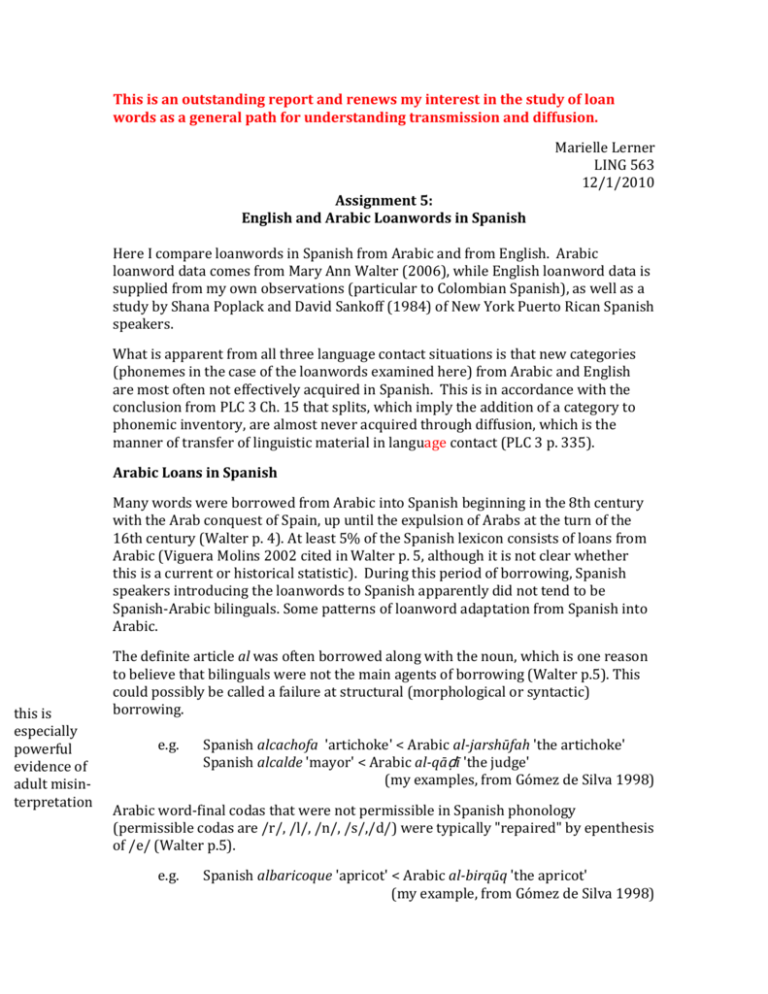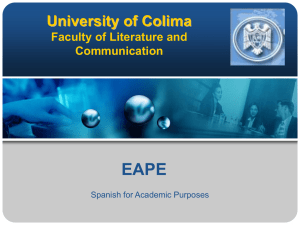This is an outstanding report and renews my interest in the study of
advertisement

This is an outstanding report and renews my interest in the study of loan words as a general path for understanding transmission and diffusion. Marielle Lerner LING 563 12/1/2010 Assignment 5: English and Arabic Loanwords in Spanish Here I compare loanwords in Spanish from Arabic and from English. Arabic loanword data comes from Mary Ann Walter (2006), while English loanword data is supplied from my own observations (particular to Colombian Spanish), as well as a study by Shana Poplack and David Sankoff (1984) of New York Puerto Rican Spanish speakers. What is apparent from all three language contact situations is that new categories (phonemes in the case of the loanwords examined here) from Arabic and English are most often not effectively acquired in Spanish. This is in accordance with the conclusion from PLC 3 Ch. 15 that splits, which imply the addition of a category to phonemic inventory, are almost never acquired through diffusion, which is the manner of transfer of linguistic material in language contact (PLC 3 p. 335). Arabic Loans in Spanish Many words were borrowed from Arabic into Spanish beginning in the 8th century with the Arab conquest of Spain, up until the expulsion of Arabs at the turn of the 16th century (Walter p. 4). At least 5% of the Spanish lexicon consists of loans from Arabic (Viguera Molins 2002 cited in Walter p. 5, although it is not clear whether this is a current or historical statistic). During this period of borrowing, Spanish speakers introducing the loanwords to Spanish apparently did not tend to be Spanish-Arabic bilinguals. Some patterns of loanword adaptation from Spanish into Arabic. this is especially powerful evidence of adult misinterpretation The definite article al was often borrowed along with the noun, which is one reason to believe that bilinguals were not the main agents of borrowing (Walter p.5). This could possibly be called a failure at structural (morphological or syntactic) borrowing. e.g. Spanish alcachofa 'artichoke' < Arabic al-jarshūfah 'the artichoke' Spanish alcalde 'mayor' < Arabic al-qāḍī 'the judge' (my examples, from Gómez de Silva 1998) Arabic word-final codas that were not permissible in Spanish phonology (permissible codas are /r/, /l/, /n/, /s/,/d/) were typically "repaired" by epenthesis of /e/ (Walter p.5). e.g. Spanish albaricoque 'apricot' < Arabic al-birqūq 'the apricot' (my example, from Gómez de Silva 1998) They were also sometimes borrowed with a different coda possible in native Spanish phonology. e.g. Spanish arrabal 'peripheral neighborhood' < Arabic al-rabaḍ '[same]' (Walter p.4-5) English Loans in Colombian Spanish There is a notable presence of English influence in the larger cities of Colombia (as in business names), although speakers who are bilingual in Spanish and English are not common. Many Colombians do emigrate to the United States, and may provide a certain degree of indirect contact with English for their family and friends who remain in Colombia. While American media is accessible and popular (particularly movies and TV shows), it is only recently, and still sporadically, being made available in original versions that are not dubbed in Spanish (these are my own impressionistic observations). English borrowings in Colombian Spanish are more or less frequent depending on semantic context (for example, many car parts are referred to with English loans), and also vary in the degree to which they are adapted to Spanish phonology. Two loanwords that are particularly well embedded in the Spanish lexicon are: ronpoi(n) [ron'poi(n)] 'rotary' < 'roundpoint' ponqué [pon'ke] '(pound) cake' Borrowing of the English affricate /tʃ/ and fricative /ʃ/ is varied in its realization. e.g. closh/clutch [kloʃ] 'clutch (pedal)' shampoo [tʃam'pu] 'shampoo' We observe similar patterns in the reading of English by Spanish dominant children The adaptation of the affricate /tʃ/ as a fricative /ʃ/ in closh may be explained by the fact that the former phoneme is not a possible word-final segment in Spanish. However, /ʃ/ is not a phoneme at all in Spanish, which seems to be the most likely explanation for the replacement of /ʃ/ with /tʃ/ in shampoo. There is also the possibility that Spanish speakers do not have difficulty producing /ʃ/, but have a confusion as to when to use English /tʃ/ and /ʃ/ because the latter does not occur in native Spanish vocabulary. As possible evidence for this, one observes L2 English errors such as /ʃer/ for chair and [tʃɪp] for ship from Spanish speakers. I believe this may be a similar phenomenon to Maya Ravindranath's findings on the same phonemes for the L2 English of Garifuna speakers in Belize. The prohibition of word-initial /sC/ clusters in Spanish is clear in English loans, and to my knowledge never violated in Colombian Spanish: e.g. spray/espray [es'prai] 'spray' stop/estop [es'top] 'tail light' I also found that word-final /m/ is adapted to /n/, according to native Spanish phonology. e.g. rin [rin] '(tire) rim' One interesting category of loans is proper names, which vary both in the nature of their phonological adaptations and orthography. Some are borrowed with English orthography and the expected Spanish phonological adjustments to the English pronunciation. e.g. Wilson ['wilson] 'Wilson' Charlie ['tʃarli] 'Charlie' Others are borrowed with English orthography and a Spanish pronunciation that seems to reflect the orthography more than an adaptation of English pronunciation, which might be evidence of a limited degree of contact. e.g. Shirley ['tʃirlei] 'Shirley' However, a third class of proper names shows orthographic adjustments that seem to reflect a more accurate Spanish representation of the English pronunciation, which may or may not be evidence of a greater degree of contact than the other two categories. e.g. Aleks ['aleks] 'Alex' Brayan ['braijan]* 'Brian' Leidy ['leiði] 'Lady' English Loans in New York Puerto Rican Spanish Poplack and Sankoff studied a subset of the stable bilingual community of New York Puerto Ricans. While all of their speakers were bilingual, the majority of adults were dominant in Spanish. Meanwhile the majority of the children studied were classified by Poplack and Sankoff as balanced bilinguals, and a few were also dominant in English (Poplack & Sankoff 106). In an elicitation task, 5 of 38 English loanwords were consistently produced with unadapted English phonology: frog, pig, Timex, tape recorder, bat * (Poplack 7 Sankoff 114) What I've transcribed with /j/ varies between a palatal glide and palatal affricate. 1 of the 38 words was entirely adapted to Spanish phonology, while the remaining 32 were partially adapted to varying degrees. On a scale of 0 to 2 as an average value across speakers for each word, with 0 indicating unadapted, and 2 indicating fully adapted, 13 loans were in the range of 0<x<1, and 19 were in the range of 1≤x<2. Words that were adapted include: suiche ['switʃe] 'switch' bebi ['beβi]* 'baby' daim [daim] 'dime' bildin ['bildin] 'building' matre ['matre] 'mattress' cóber ['koβer] 'cover' zíper ['siper]/zipa ['sipa] 'zipper' suéter ['sweter]/suera ['swera] 'sweater' (Poplack & Sankoff 114,124; IPA my own, inferred from Spanish spelling given) Having further evaluated the degree of integration of loanwords across generations, Poplack and Sankoff found that childhood bilinguals do not tend to acquire borrowings more faithfully (to the source language) than adult learners. Interestingly, this does not imply less-than-native phonology in the bilingual child's English: Indeed, if we were to hear someone produce roof rather than rufo in an otherwise Spanish context, we would have good reason to consider this an instance of code-switching rather than borrowing. (Poplack & Sankoff p. 126) Conclusion This seems to me to be a crucial area for further study of the loan process but takes a great deal more thought as to what each process would produce. In the first two contact situations it is likely that a large majority of the borrowers involved are non-bilingual Spanish speakers. It is no surprise then that the process of borrowing for these speakers should be diffusion, and show evidence of the imperfect acquisition of new grammatical categories. The third case, of New York Puerto Rican Spanish speakers, is different in that children are bilingual from a young age, and may even be dominant in English. This case may reinforce the stronger conclusion that even within the critical period for language acquisition, children are not likely to acquire new grammatical categories through diffusion, but only through transmission; the majority of English loanwords in New York Puerto Rican Spanish are also adapted, at least partially, to Spanish phonology. Other evidence for this includes Payne's 1976 and 1980 studies of the acquisition of the Philadelphia split short-a system by children of inmigrant parents in King of Prussia, and Trudgill's study of the own and goal vowels among Norwich speakers of localborn and inmigrant parents. * In Colombian Spanish this is ['beiβi] References Gómez de Silva, Guido (ed.). 1998. Breve Diccionario Etimológico de la Lenga Española. Fonda de Cultura Económica: México, D. F. Poplack, Shana, and David Sankoff. 1984. Borrowing: the synchrony of integration. Linguistics 22:99-135. Walter, Mary Ann. 2006. Grammatical gender via lexical statistics: the case of Arabic-toSpanish loanwords. In F.F. Hsieh & Michael Kenstowicz (eds.) Studies in Loanword Phonology, MIT Working Papers in Linguistics 52.








